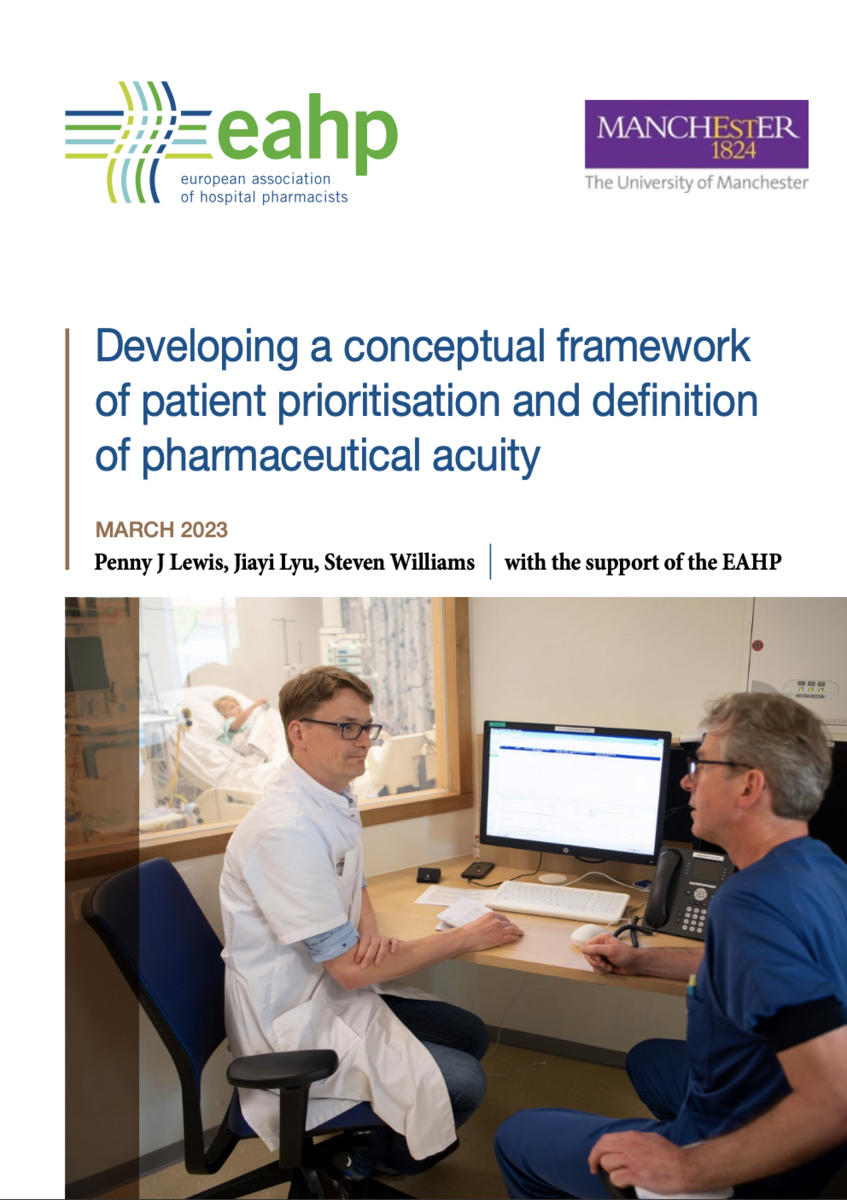Conceptual model of patient prioritisation and a definition for pharmaceutical acuity
Brussels, April 11. There has been an increasing interest in the topic of patient prioritisation for hospital pharmacy services in the past few years. The need for prioritisation processes or tools in pharmacy has been driven by pressures on healthcare systems, in particular during these last years. The pressure on hospital pharmacy services was heightened by the Covid-19 pandemic, which dramatically reduced hospital workforce capacity.
Dr Penny Lewis and Ms Jiayi Lyu from the University of Manchester approached EAHP back in 2021 to collaborate on developing a definition for pharmaceutical acuity. Given the importance of this topic and the absence of an existing definition of acuity from the pharmacy perspective, the EAHP team decided to provide support in particular in the set-up and coordination of the consensus workshops that developed the final versions of the definition and conceptual model for pharmaceutical acuity. This project lies within EAHP’s aim to support its member countries to move towards the implementation of the European Statements of Hospital Pharmacy.
The project aiming to create a definition for pharmaceutical acuity was divided in three different phases: a screening of the existing assessment tools, a thorough and detailed literature review and the set-up of expert consensus workshops. In addition, a patient group provided input on the final draft definition. The report prepared by Dr Penny Lewis, Ms Jiayi, and Steven Williams, with the support of EAHP, explores the notion of acuity in relation to pharmacy to support the development of a conceptual definition of pharmaceutical acuity.
EAHP President Andras Süle remarked that “Healthcare systems need to allocate resources in the most efficient way while ensuring a high degree of safety and quality. For that reason, prioritisation of hospital and clinical pharmacy activities is an important aspect in the delivery of pharmaceutical care. This report marks a landmark as a conceptual framework and a definition for patient acuity that formerly did not exist from the pharmaceutical perspective”.
Dr Penny Lewis commented that “Pharmacy teams have a vital role in ensuring the safe and effective use of medicines and interest in how to best allocate pharmacy expertise to ensure the right pharmacist, sees the right patient at the right time has risen substantially over recent years. In order to drive this agenda forward and promote a shared understanding within healthcare, we have developed a conceptual framework of patient prioritisation for pharmacy services and the first definition of acuity for use in a pharmacy context”.

For further information contact
info[at]eahp[dot]eu | 00 322 669 2513
info[at]eahp[dot]eu | 00 322 669 2513
1. The European Association of Hospital Pharmacists (EAHP) is a not-for-profit organisation that defends the interests of more than 27000 European hospital pharmacists from its 36 full and associate member organisations. EAHP works to develop knowledge on hospital pharmacy to ease the improvement of care and outcomes for patients in the hospital setting. The Association achieves this through science, practice, research, education, as well as sharing best-practice and responsibility with other healthcare professionals. More information about EAHP is available HERE.
2. Dr Penny Lewis is a Senior Clinical Lecturer at the University of Manchester and Academic Lead for Pharmacy Research at Manchester University Foundation Trust, UK. Her research focuses on patient safety and the effective delivery of pharmacy services to improve patient care.
3. Ms Jiayi Lyu is a final year pharmacy student at the University of Manchester. Ms Lyu has undertaken her final year masters project ‘Exploring pharmaceutical acuity’ with Dr Lewis.
4. Mr Steven Williams is a former Hospital Consultant Pharmacist in Medicine & Medication Safety, and now is a Senior Clinical Pharmacist in Primary Care. He is an Associate Editor of the EJHP, an honorary clinical lecturer at the Manchester Pharmacy School, and worked with Dr Lewis on many medication safety projects
4. The report can be found HERE
12 April 2023




